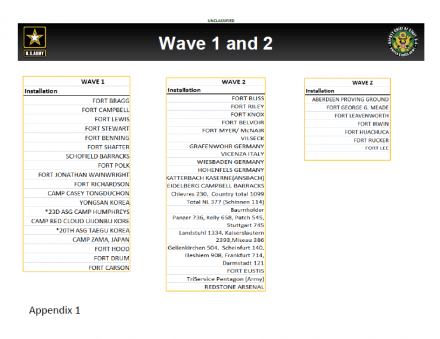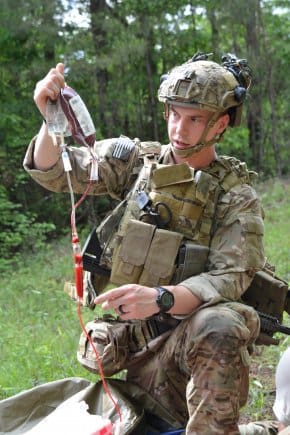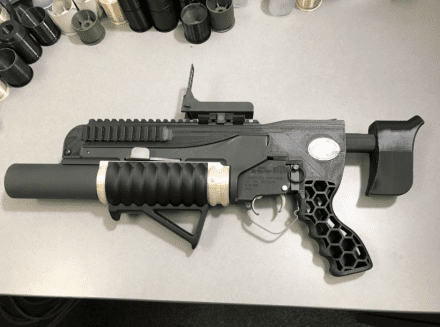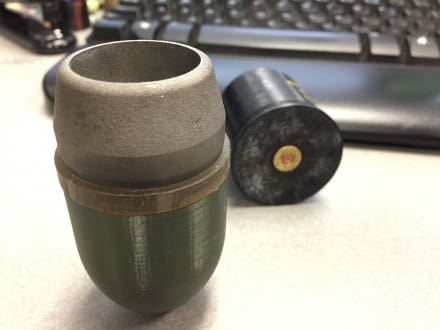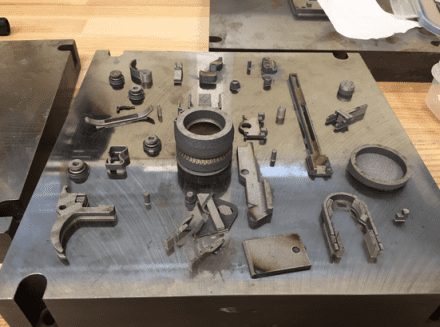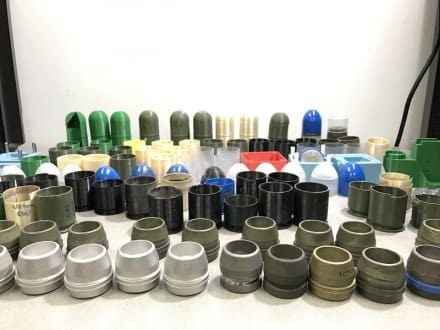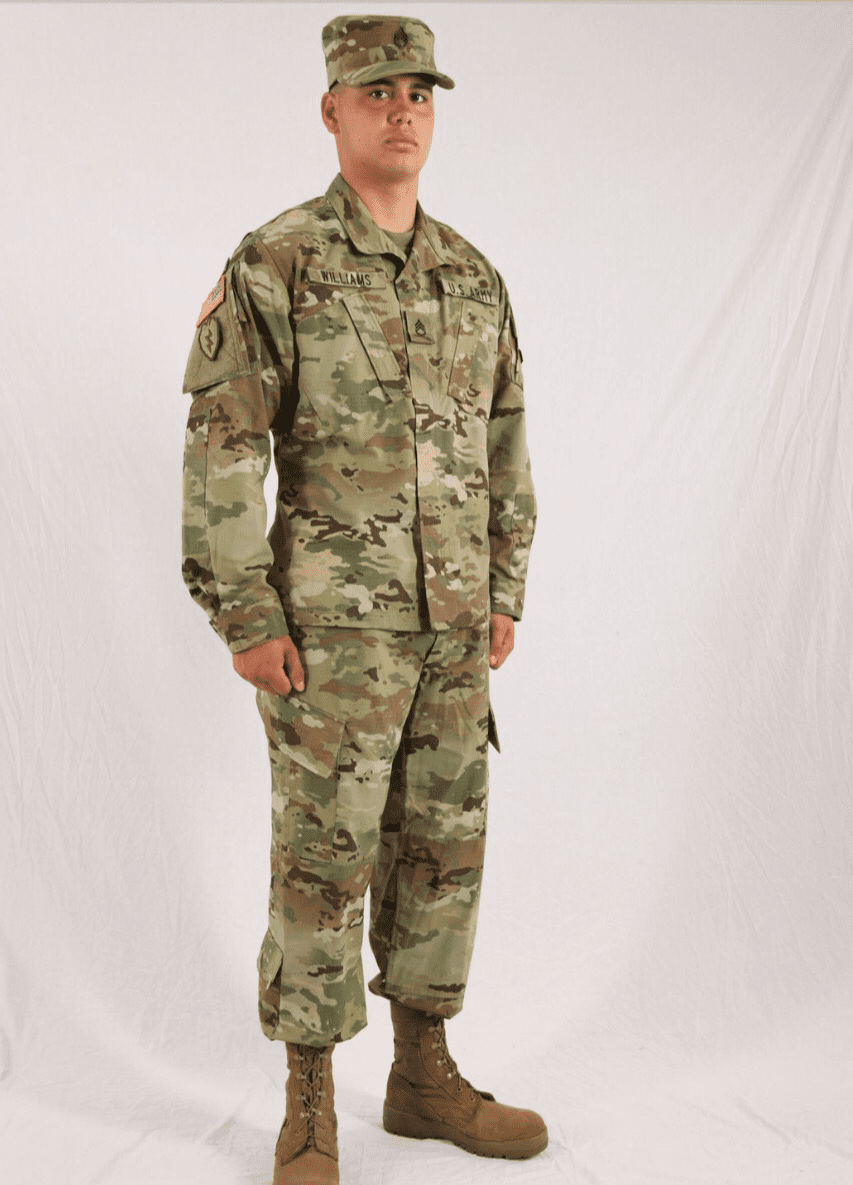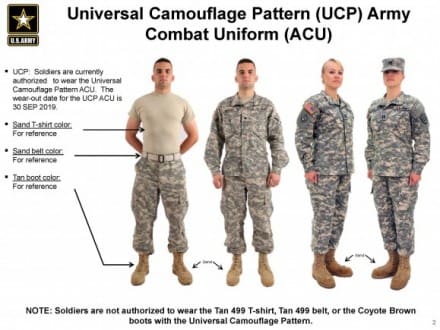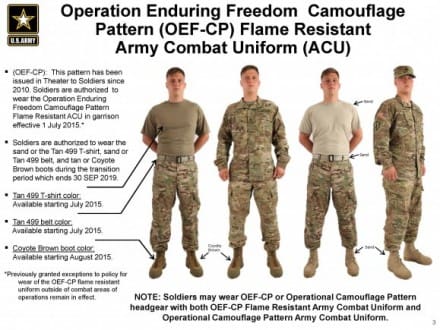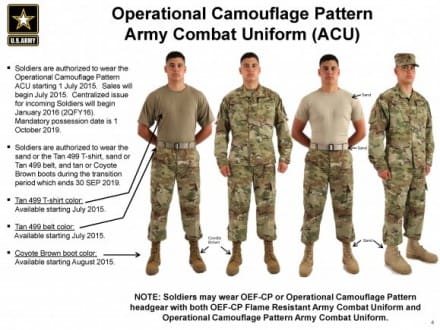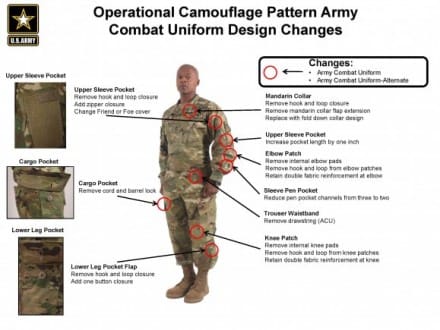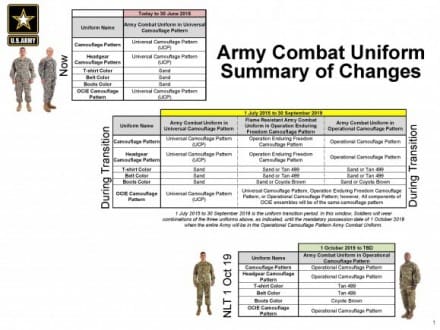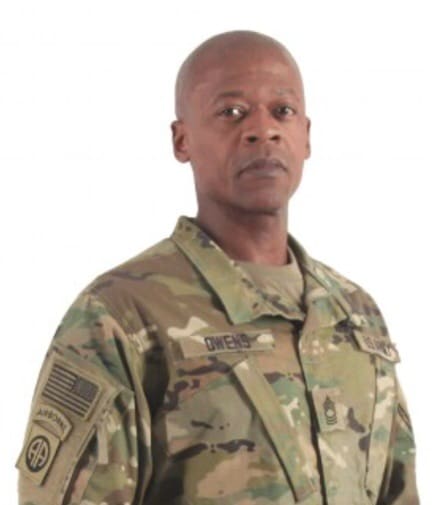The US Army has finally officially issued the long awaited ALARACT for the OCP transition. The ALARACT in its entirety can be read below, along with the uniform issue waves.
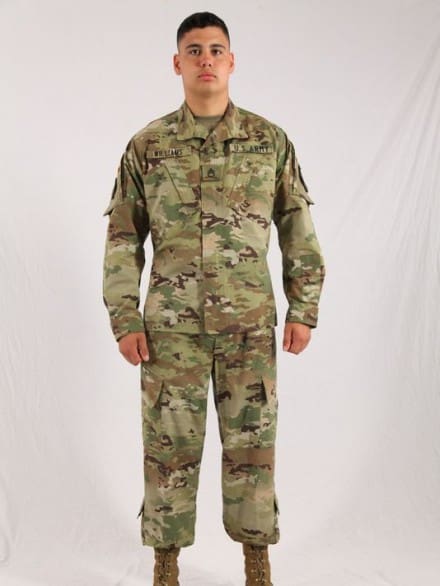
ALARACT 085/2015
DTG: R 012016Z JUN 15
UNCLAS
SUBJ/ALARACT 085/2015 – TRANSITION TO OPERATIONAL CAMOUFLAGE PATTERN ARMY COMBAT UNIFORM (ACU) ENSEMBLE
THIS ALARACT MESSAGE HAS BEEN TRANSMITTED BY USAITA ON BEHALF OF HQDA DCS G-4//DALO-SUT//
(U) REFERENCES.
A. ARMY POSTURE STATEMENT, 2013
B. ARMY CAMPAIGN PLAN, 2013
C. AR 670-1, 10 APRIL 2015
D. DA PAM 670-1, 10 APRIL 2015
E. HOUSE REPORT 111-151, SEPTEMBER 2009
1. (U) THE PURPOSE OF THIS MESSAGE IS TO PROVIDE INFORMATION ON THE TRANSITION FROM THE UNIVERSAL CAMOUFLAGE PATTERN AND OPERATION ENDURING FREEDOM CAMOUFLAGE PATTERN ACU TO THE OPERATIONAL CAMOUFLAGE PATTERN ACU. THIS MESSAGE ALSO PROVIDES GUIDANCE ON THE WEAR OF THE OPERATIONAL CAMOUFLAGE PATTERN ACU ENSEMBLE AS APPROVED BY THE SECRETARY OF ARMY AND CHIEF OF STAFF OF THE ARMY ON 1 MAY 2014. POLICY CONTAINED IN THIS MESSAGE IS EFFECTIVE 1 JULY 2015. PREVIOUSLY GRANTED EXCEPTIONS TO POLICY FOR WEAR OF THE OPERATION ENDURING FREEDOM CAMOUFLAGE PATTERN UNIFORM OUTSIDE OF COMBAT AREAS OF OPERATIONS REMAIN IN EFFECT.
2. (U) DURING THE TRANSITION PERIOD, SOLDIERS ARE AUTHORIZED TO WEAR ANY OF THE THREE CAMOUFLAGE PATTERNS OF THE ACU (UNIVERSAL CAMOUFLAGE PATTERN, OPERATION ENDURING FREEDOM CAMOUFLAGE PATTERN, AND THE OPERATIONAL CAMOUFLAGE PATTERN). ALL COMPONENTS OF THE UNIFORM MUST BE OF THE SAME CAMOUFLAGE PATTERN UNLESS OTHERWISE STATED IN THIS MESSAGE. COMMANDERS WILL NOT REQUIRE SOLDIERS TO PURCHASE SPECIFIC UNIFORM ITEMS PRIOR TO THE MANDATORY POSSESSION DATE LISTED IN PARAGRAPH 10 BELOW.
3. (U) THE OPERATIONAL CAMOUFLAGE PATTERN ACU ENSEMBLE CONSISTS OF THE FOLLOWING ITEMS:
3.A. COAT
3.B. TROUSERS
3.C. UNDERSHIRT (TAN 499)
3.D. BELT, RIGGER (TAN 499)
3.E. DRAWERS (TAN 499)
3.F. SOCKS, TAN, GREEN OR BLACK, CUSHION SOLE
3.G. BOOTS, COMBAT, COYOTE COLOR
3.H. HEADGEAR
4. (U) ACU WEAR POLICY. THERE IS NO CHANGE TO CURRENT WEAR POLICY (AR 670-1) EXCEPT AS NOTED BELOW.
4.A. DURING THE TRANSITION PERIOD, CLOTHING INITIAL ISSUE POINTS ARE AUTHORIZED TO CONTINUE TO ISSUE TO INITIAL ENTRY TRAINING SOLDIERS THE TAN/SAND COLORED UNDERGARMENTS WITH THE OPERATIONAL CAMOUFLAGE PATTERN ACU. SOLDIERS ARE AUTHORIZED TO WEAR THE SAND UNDERSHIRT; WHITE, TAN OR BROWN DRAWERS; SAND RIGGER BELT; AND TAN COMBAT BOOTS WITH THE OPERATION ENDURING FREEDOM AND/OR OPERATIONAL CAMOUFLAGE PATTERN ACU COAT AND TROUSERS. THE TAN 499 UNDERSHIRT, TAN 499 RIGGER BELT, AND COYOTE COMBAT BOOTS ARE NOT AUTHORIZED FOR WEAR WITH THE UNIVERSAL CAMOUFLAGE PATTERN COAT AND TROUSERS.
4.B. THE EXCEPTIONS OUTLINED ABOVE ALSO APPLIES TO THE COMBAT VEHICLE CREWMAN UNIFORM, MECHANIC COVERALLS, AND THE ARMY AIRCREW COMBAT UNIFORM (A2CU).
5. (U) INSIGNIA AND ACCOUTERMENTS WORN ON THE ACU MUST BE OF THE CORRESPONDING CAMOUFLAGES PATTERN COLOR. THE BACKGROUND MATERIAL OF NAME TAPES, SHOULDER SLEEVE INSIGNIA, TABS, GRADE INSIGNIA, FORMER WARTIME SERVICE, AND SEW-ON BADGES WILL MATCH THE CAMOUFLAGE PATTERN OF THE UNIFORM.
6. (U) THE RAPID FIELDING INITIATIVE WILL CONTINUE TO ISSUE SOLDIERS FLAME RESISTANT ARMY COMBAT UNIFORMS IN THE OPERATION ENDURING FREEDOM CAMOUFLAGE PATTERN UNTIL INVENTORIES ARE EXHAUSTED.
7. (U) THE ARMY’S PLAN TO TRANSITION TO THE OPERATIONAL CAMOUFLAGE PATTERN ACU STARTING 1 JULY 2015 AND END 1 OCTOBER 2019. THE OPERATIONAL CAMOUFLAGE PATTERN ACU WILL BE AVAILABLE AS FOLLOWS:
7.A. (U) IN ARMY MILITARY CLOTHING STORES (AMCS) BY INSTALLATION IAW THE ENCLOSED APPENDIX. DA FORM 3078 PERSONAL CLOTHING REQUESTS WILL NOT BE ACCEPTED FOR OPERATIONAL CAMOUFLAGE PATTERN ACU UNTIL JANUARY 2016. EXCEPTIONS TO POLICY PRIOR TO THE START DATE WILL ONLY BE GRANTED BY THE CLOTHING AND SERVICES OFFICE.
7.B. AT THE CLOTHING INITIAL ISSUE POINT LOCATIONS FOR INITIAL ENTRY TRAINING SOLDIERS IN 2QFY16.
7.C. FOR SOLDIERS (ACTIVE DUTY AND UNITED STATES ARMY RESERVE (USAR)) ON ORDERS TO PERFORM DRILL SERGEANT DUTIES AND ADVANCED INDIVIDUAL TRAINING PLATOON SERGEANTS ARE AUTHORIZED TO OBTAIN THEIR SUPPLEMENTAL ISSUE OF THE OPERATIONAL CAMOUFLAGE PATTERN ACU FROM THEIR LOCAL AMCS BEGINNING ON 15 DECEMBER 2015 (1QFY16) AND HAVE 90 DAYS TO DRAW THEIR SUPPLEMENTAL ISSUE IN ACCORDANCE WITH COMMON TABLE ALLOWANCES 50-900, TABLE NUMBER 3.
7.D. AT THE CLOTHING CENTRAL DISTRIBUTION FACILITY AT THE KENTUCKY LOGISTICS OPERATIONS CENTER FOR ARMY NATIONAL GUARD, USAR, AND SENIOR RESERVE OFFICER TRAINING CORPS IN 4QFY16.
8. (U) THE WEAR OUT DATE FOR THE UNIVERSAL CAMOUFLAGE PATTERN ACU IS 30 SEPTEMBER 2019.
9. (U) THE MANDATORY POSSESSION DATE FOR THE OPERATIONAL CAMOUFLAGE PATTERN ACU IS 1 OCTOBER 2019.
10. (U) HQDA G-1 POC FOR UNIFORM WEAR POLICY IS SGM EVA COMMONS, DSN: 312-225-5473, COMMERCIAL: (703) 695-5473, OR E-MAIL: EVA.M.COMMONS.MIL@MAIL.MIL. HQDA G-4 POC IS MAJ DANNY PADELLO, DSN: 224-2718, COMMERCIAL: (703) 614-2718, OR E-MAIL: DANIEL.E.PADELLO.MIL@MAIL.MIL.
11. (U) THIS MESSAGE HAS BEEN AUTHORIZED BY THE ARMY G-1 AND ARMY G-4.
12. (U) THE DEPUTY CHIEF OF STAFF, G-1 IS THE PROPONENT OF WEAR AND APPEARANCE OF ARMY UNIFORMS AND INSIGNIA POLICY AND WILL INCORPORATE THE GUIDANCE IN THIS MESSAGE INTO REFERENCE D BY 1 JULY 2015.
13. (U) THIS MESSAGE EXPIRES 15 MAY 2016.
Click to view .pdf